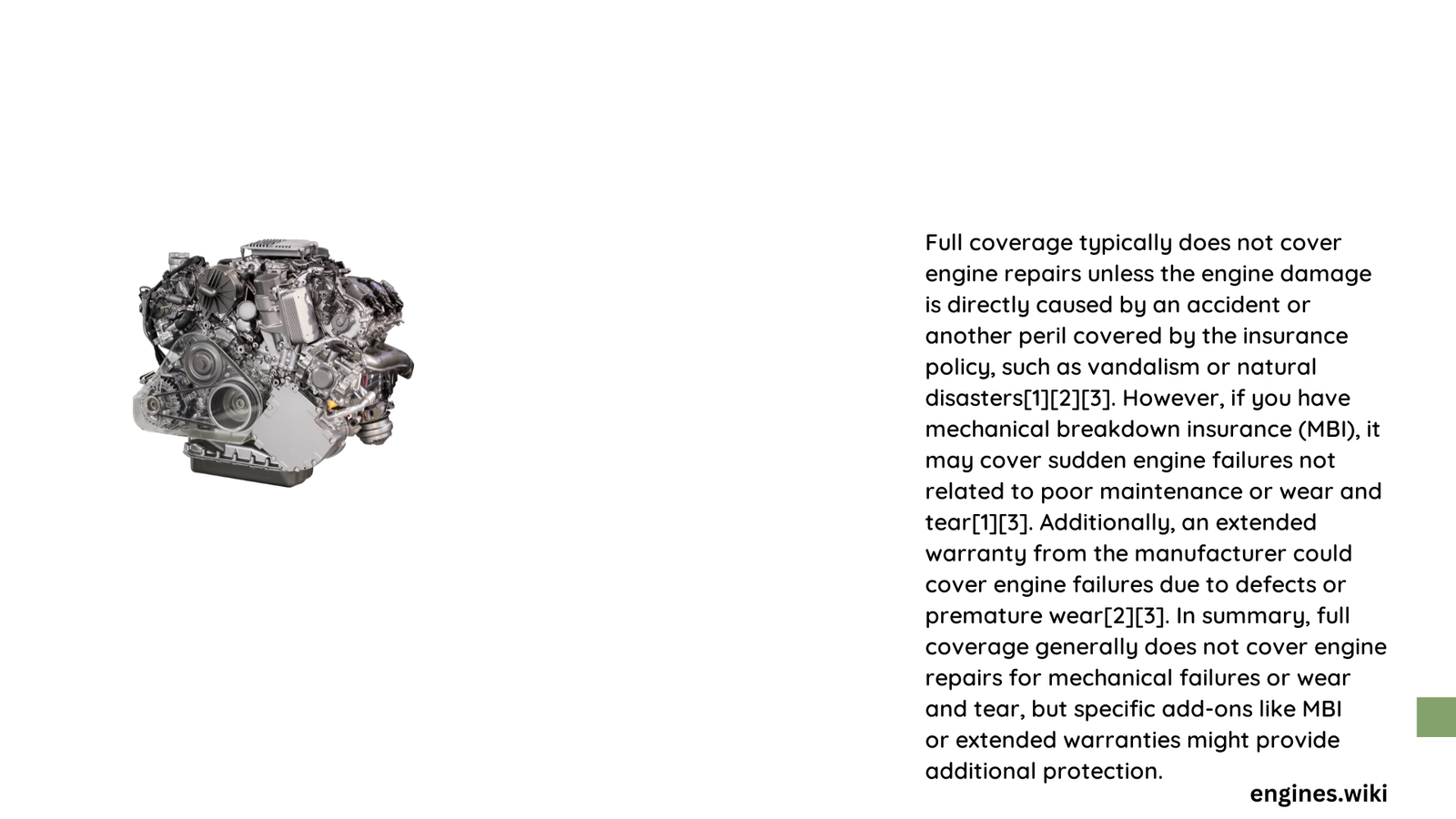Full coverage car insurance provides complex protection for vehicle owners, but understanding its limitations regarding engine damage is crucial. While comprehensive and collision policies offer broad protection, they do not universally cover all engine-related issues. Mechanical failures, wear and tear, and maintenance-related problems typically fall outside standard insurance coverage, leaving vehicle owners potentially responsible for significant repair expenses.\n\n## What Determines Engine Damage Coverage in Full Insurance?\n\nFull coverage insurance involves multiple layers of protection that impact engine damage claims. Understanding these nuanced aspects helps vehicle owners make informed decisions about their insurance needs.\n\n### Does Comprehensive Coverage Protect Engine Components?\n\nComprehensive coverage addresses engine damage under specific circumstances:\n\n- Covered Events:\n 1. Natural disasters (floods, hurricanes)\n 2. Vandalism\n 3. Animal-related damage\n 4. Falling objects\n 5. Unexpected external incidents\n\n- Exclusions:\n 1. Mechanical wear\n 2. Manufacturing defects\n 3. Lack of routine maintenance\n\n### What Triggers Engine Damage Insurance Claims?\n\n| Claim Trigger | Coverage Status | Typical Response |\n|————–|—————-|——————|\n| Collision Damage | Typically Covered | Insurance pays repair costs |\n| Natural Disaster | Usually Covered | Comprehensive policy applies |\n| Mechanical Failure | Generally Rejected | Owner’s responsibility |\n| Maintenance Neglect | Not Covered | Claim denied |\n\n### How to Maximize Engine Damage Protection?\n\nVehicle owners can enhance their engine protection through strategic insurance approaches:\n\n1. Add Mechanical Breakdown Insurance (MBI)\n – Specifically covers mechanical failures\n – Often available as optional coverage\n – Provides extended protection beyond standard policies\n\n2. Maintain Detailed Service Records\n – Document regular maintenance\n – Proves proactive vehicle care\n – Strengthens potential insurance claims\n\n3. Consider Extended Warranty Options\n – Supplements existing insurance coverage\n – Provides additional mechanical failure protection\n\n### What Documentation Supports Engine Damage Claims?\n\nSuccessful insurance claims require comprehensive documentation:\n\n- Detailed repair estimates\n- Professional mechanic assessments\n- Photographic evidence of damage\n- Maintenance service records\n- Incident reports (if applicable)\n\n### Are There Cost Implications for Engine Damage Claims?\n\nInsurance claims involve financial considerations:\n\n- Deductible Ranges: $500 – $2,000\n- Potential Premium Increases: Likely after significant claims\n- Actual Cash Value Limitations: Repairs might exceed vehicle worth\n\n## Expert Recommendations\n\nTo maximize engine damage protection:\n\n- Review policy details carefully\n- Understand specific coverage limitations\n- Consider supplemental insurance options\n- Maintain rigorous vehicle maintenance\n- Consult insurance professionals for personalized guidance\n\n### Final Insights on Engine Damage Coverage\n\nWhile full coverage insurance provides substantial protection, it does not guarantee comprehensive engine repair coverage. Vehicle owners must proactively understand their policy’s specifics, maintain their vehicles, and consider additional protection mechanisms.\n\n### References:\n- https://www.progressive.com/answers/does-insurance-cover-engine-repairs/\n- https://www.plymouthrock.com/resources/does-car-insurance-cover-engine-failure\n- https://www.bankrate.com/insurance/car/engine-failure/\n

